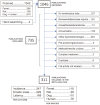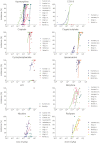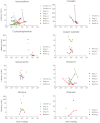Predicting the emetic liability of novel chemical entities: a comparative study
- PMID: 21913900
- PMCID: PMC3372835
- DOI: 10.1111/j.1476-5381.2011.01669.x
Predicting the emetic liability of novel chemical entities: a comparative study
Abstract
Background and purpose: Emesis is a multi-system reflex, which is usually investigated using in vivo models. The aim of the study is to compare the response induced by emetic compounds across species and investigate whether dogs, ferrets and rats are all similarly predictive of humans.
Experimental approach: A systematic review was carried out and relevant publications were identified from PubMed. The search was restricted to four species (human, dog, ferret, rat) and ten compounds representative of various mechanisms of emesis induction (apomorphine, cisplatin, cholecystokinin octapeptide, copper sulphate, cyclophosphamide, ipecacuanha, lithium chloride, morphine, nicotine, rolipram).
Key results: 1046 publications were reviewed, and 311 were included, the main reason for exclusion was the lack of quantitative data. Emetic or pica data were extracted as incidence, intensity or latency. All three animal species identified emetic liability but interspecies differences for dose sensitivity were detected.
Conclusions and implication: These results suggest that emetic liability can be reliably identified in a common laboratory species such as the rat. However, to evaluate the characteristics of the emetic response, no animal species is a universal predictor of emetic liability and the choice of species should be an informed decision based on the type of compound investigated. Limitations relating to the conduct and reporting of emesis studies were identified, the main ones being the lack of comparable outcome measures between human and animal data, and the limited availability of human data in the public domain.
© 2011 The Authors. British Journal of Pharmacology © 2011 The British Pharmacological Society.
Figures





Similar articles
-
A rapid and systematic review of the clinical effectiveness and cost-effectiveness of topotecan for ovarian cancer.Health Technol Assess. 2001;5(28):1-110. doi: 10.3310/hta5280. Health Technol Assess. 2001. PMID: 11701100
-
Drugs for preventing postoperative nausea and vomiting in adults after general anaesthesia: a network meta-analysis.Cochrane Database Syst Rev. 2020 Oct 19;10(10):CD012859. doi: 10.1002/14651858.CD012859.pub2. Cochrane Database Syst Rev. 2020. PMID: 33075160 Free PMC article.
-
Intravenous magnesium sulphate and sotalol for prevention of atrial fibrillation after coronary artery bypass surgery: a systematic review and economic evaluation.Health Technol Assess. 2008 Jun;12(28):iii-iv, ix-95. doi: 10.3310/hta12280. Health Technol Assess. 2008. PMID: 18547499
-
Home treatment for mental health problems: a systematic review.Health Technol Assess. 2001;5(15):1-139. doi: 10.3310/hta5150. Health Technol Assess. 2001. PMID: 11532236
-
A rapid and systematic review of the clinical effectiveness and cost-effectiveness of paclitaxel, docetaxel, gemcitabine and vinorelbine in non-small-cell lung cancer.Health Technol Assess. 2001;5(32):1-195. doi: 10.3310/hta5320. Health Technol Assess. 2001. PMID: 12065068
Cited by
-
Appropriateness to set a group health based guidance value for nivalenol and its modified forms.EFSA J. 2017 Apr 19;15(4):e04751. doi: 10.2903/j.efsa.2017.4751. eCollection 2017 Apr. EFSA J. 2017. PMID: 32625457 Free PMC article.
-
Phosphodiesterase 4 inhibitor activates AMPK-SIRT6 pathway to prevent aging-related adipose deposition induced by metabolic disorder.Aging (Albany NY). 2018 Sep 18;10(9):2394-2406. doi: 10.18632/aging.101559. Aging (Albany NY). 2018. PMID: 30227388 Free PMC article.
-
The role of the parasympathetic nervous system in visually induced motion sickness: systematic review and meta-analysis.Exp Brain Res. 2014 Aug;232(8):2665-73. doi: 10.1007/s00221-014-3964-3. Epub 2014 May 4. Exp Brain Res. 2014. PMID: 24792503
-
Evaluation of chemically diverse 5-HT₂c receptor agonists on behaviours motivated by food and nicotine and on side effect profiles.Psychopharmacology (Berl). 2013 Apr;226(3):475-90. doi: 10.1007/s00213-012-2919-2. Epub 2012 Nov 25. Psychopharmacology (Berl). 2013. PMID: 23184281
-
Comparison of emetic potencies of the 8-ketotrichothecenes deoxynivalenol, 15-acetyldeoxynivalenol, 3-acetyldeoxynivalenol, fusarenon X, and nivalenol.Toxicol Sci. 2013 Jan;131(1):279-91. doi: 10.1093/toxsci/kfs286. Epub 2012 Sep 20. Toxicol Sci. 2013. PMID: 22997060 Free PMC article.
References
-
- Andrews PLR, Davis CJ. Physiology of emesis induced by anti-cancer therapy. In: Reynolds J, Andrews PL, Davis CJ, editors. Serotonin and the Scientific Basis of Anti-Emetic Therapy. Oxford: Oxford Clinical Communications; 1995. pp. 25–49.
-
- Billig I, Yates BJ, Rinaman L. Plasma hormone levels and central c-Fos expression in ferrets after systemic administration of cholecystokinin. Am J Physiol Regul Integr Comp Physiol. 2001;281:R1243–R1255. - PubMed
-
- Borison HL. Area postrema: chemoreceptor circumventricular organ of the medulla oblongata. Prog Neurobiol. 1989;32:351–390. - PubMed
Publication types
MeSH terms
Substances
LinkOut - more resources
Full Text Sources
Medical
Molecular Biology Databases

